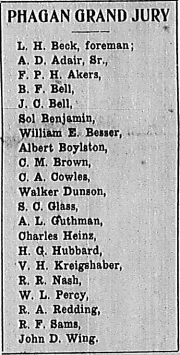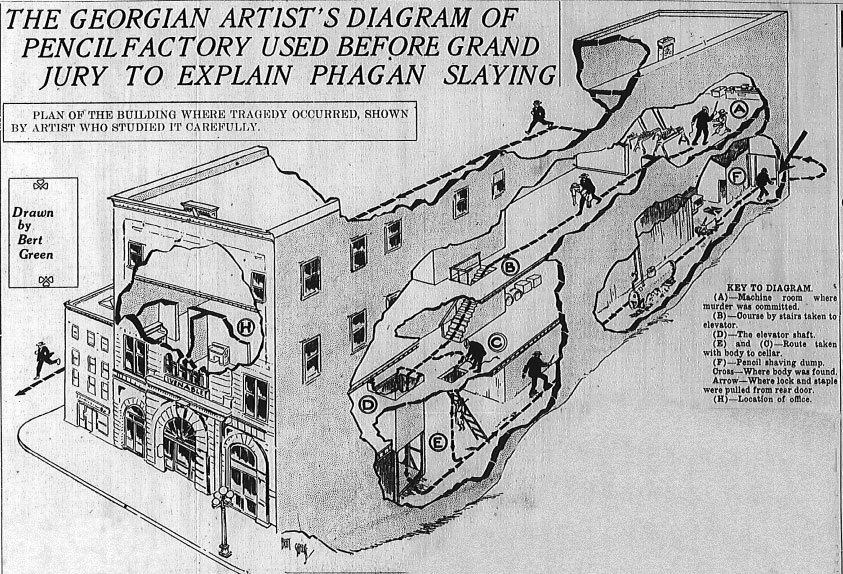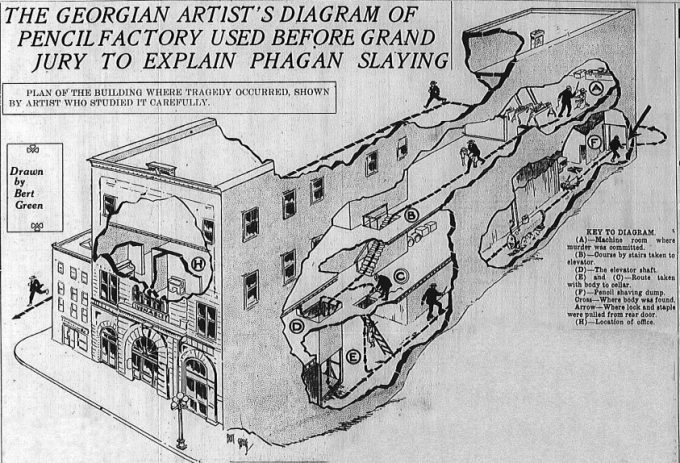Another in our series of new transcriptions of contemporary articles on the Leo Frank case.
Atlanta Georgian
Friday, May 23rd, 1913
Great Mass of Evidence Carefully Prepared by Solicitor Submitted to Grand Jury.
CRIME STUDIED 3 HOURS, ADJOURNS TILL SATURDAY
Utmost Care Taken to Insure Secrecy at the Investigation, Diagram Studied.
The Phagan case is now in the process of investigation by the Fulton County Grand Jury.
Two bills for indictment of Leo M. Frank and Newt Lee, for the murder of Mary Phagan, were presented before that tribunal at its session Friday morning by Solicitor Dorsey.
A host of witnesses gave their testimony. The torn and blood-stained clothing of the slain girl also was turned over to the Grand Jury for inspection.
The Grand Jury studied carefully an elaborate diagram drawn by Bert Green, one of the Georgian’s staff artists, and setting forth in black and white the prosecutor’s theory of how the murder was probably committed. Intense interest was displayed in the drawing.
After being in session for nearly three hours, the Grand Jury adjourned until to-morrow morning at 10 o’clock, when the Phagan case will be taken up once more.
Woman Gives New Testimony.
Whether the sensational testimony of Mrs. Mima [sic] Famby [sic], 400 Piedmont Avenue—or Nina Famby [sic], as the woman says her name is—will be introduced at the Grand Jury probe, is a matter of doubt. Mrs. Fomby’s affidavit declaring that on the evening of the murder Frank called the affiant on the telephone and in an excited voice asked her to arrange a room for himself and a girl whose name he would not disclose, is in the hands of the Solicitor General.
Important as is the bearing which the alleged telephone conversation appears to have on the mystery of Mary Phagan’s death, doubts are already being expressed as to the part it will be permitted to play in the present hearing or any to come, owing to the chary wording of the law on such evidence.
It is supposed, however, that if Mrs. Fomby’s affidavit is admitted, an immediate attempt to attack her credibility will be made by the defense. Her own story puts the credibility of her testimony in doubt.
[Woman Makes Affidavit That Pencil Factory Superintendent Tried to Rent Room for Himself and Girl on the Day Mary Phagan Was Killed.
Bills of indictment charging Leo M. Frank and Newt Lee with the murder of Mary Phagan were presented to the Grand Jury this morning. The announcement from Solicitor Dorsey came as a distinct surprise as it had been intimated on several occasions one of the two would be named as an accessory to the fact.
One of the most important witnesses summoned is Mrs. Mima Famby, 400 Piedmont Avenue, who, according to her affidavit, will testify that Frank telephoned her the evening of the murder and endeavored to arrange for a room for himself and a girl whose name he would not disclose. The Solicitor said Mrs. Famby would hardly testify Friday, but would before the Grand Jury finished the case.
Important as is the bearing which this alleged telephone conversation appears to have on the mystery of Mary Phagan’s death, doubts already are being expressed as to the part it will be permitted to have with the evidence that is being presented to warrant the indictment of Frank and Lee.
The law always has been very chary of accepting telephone conversations as evidence in a court of justice, except under the most unusual circumstances, where there was opportunity for the fullest corroboration. These circumstances do not appear to exist in the alleged telephone conversations between Frank and Mrs. Famby.
Mrs. Famby Is Ill.
Whether the usual reluctance of the law to accept such testimony will be waived by the Grand Jury probably will not be known Friday, as Mrs. Famby was reported sick in bed at her home Friday morning, and she refused to talk to anyone in regard to the case.
“Mrs. Famby is very sick,” said the nurse, Mrs. Emma F. Rivers. “She cannot be seen to-day. She is slightly better, however, than she was yesterday, and it is possible that she will be practically recovered by Saturday.”
It is to be supposed that if Mrs. Famby’s testimony is admitted there will be an immediate attempt to attack her credibility. Some of the statements in her affidavit will be fol[l]owed out, and an investigation will be made of the facts of her private life, so far as they may affect the probable truth of her statements.
John W. Moore, attorney in the Grace and Applebaum cases, said to-day that the Georgia law would permit the introduction of telephone conversations in evidence if the person testifying could swear positively that he or she knew the voice at the other end of the line. — Added from the “Afternoon” edition — Ed.]
Frank Refused to Talk.
Frank, when interviewed in his cell at the Tower Friday morning regarding the telephone conversation and his dealings with Mrs. Fomby in general, refused to discuss the question.
“I am feeling fine, “ he said, but would not discuss the crime at all.
Among the witnesses who went before the Grand Jury were:
Dr. J. W. Hurt, Coroner’s physician, who examined the dead girl’s body the morning after it was found.
T. W. Epps, the newsboy who waited at the corner on the afternoon of the tragedy for Mary Phagan while she went to the factory to get pay envelope.
Detective a Witness.
Harry Scott, assistant superintendent of the local branch of the Pinkerton detective agency, who has been investigating the mysterious case.
J. N. Starnes, a city detective.
M. D. Darley, Frank’s assistant at the pencil factory.
L. S. Dobbs, sergeant of police, who answered Lee’s call to the pencil factory the morning the body was found.
“Boots” Rogers, former county policeman, who drove the police to the factory in his automobile in answer to Lee’s call.
Pat Campbell, city detective.
Bass Rosser, city detective.
Utmost secrecy clothed the Grand Jury’s investigation. The cracks about the doors and windows of their room on the second floor of the Thrower Building were lined with paper in order that no chance conversation or view of the proceedings might escape.
Great Throng in Corridors.
An immense throng crowded the corridors of the building and filled the adjoining rooms.
The witnesses were all bunched into the ante-room and there kept waiting while one at a time they entered before the tribunal and told what they knew regarding the death of Mary Phagan.
Dr. Hurt was the first witness to go before the Grand Jury. He went into their room at 10:55 in the morning. He was dismissed at 11:23. Dr. Hurt’s testimony, through his examination of the body, is considered of vast importance. He declined to make any statement whatsoever as he left the building.
In rapid succession other witnesses followed. Their testimony, which is believed will weave the preliminary chair of evidence about Frank and Lee which will warrant their indictment, was placed before the Grand Jury.
Sergeant Dobbs Testifies.
Police Sergeant Dobbs followed Dr. Hurt into the Grand Jury room at 11:49. His testimony is supposed to consist mainly of the condition of the Phagan girl’s body when he arrived on the scene, including its location and the evidence surrounding it. Most important probably of his testimony was that as to the actions of the negro, Newt Lee, as he led the police squad to the body and while the initial examination of it took place in the basement of the factory.
 City Detective Starnes, after Dobbs’ departure, took into the Grand Jury room a map of the pencil factory, showing the floor upon which the girl is supposed to have met her slayer, tracing the trail along which he dragged the body down into the basement.
City Detective Starnes, after Dobbs’ departure, took into the Grand Jury room a map of the pencil factory, showing the floor upon which the girl is supposed to have met her slayer, tracing the trail along which he dragged the body down into the basement.
The rapidity with which the wheels of justice revolved at the hearing bore out Solicitor Dorsey’s statement that when he presented his evidence before the Grand Jury it would be in a clear, concise form.
That the prosecution will avoid presenting its most incriminating evidence before the tribunal, unless necessary to secure indictments of the two men, was admitted in the Solicitor’s office just before the Grand Jury convened. No more than enough evidence to secure true bills will be revealed, it was said.
Woman Makes Affidavit.
The affidavit of Mrs. Mima Fomby, who told of Frank trying to get a room at her place was signed in office of Chief of Detectives Newport Lanford May 11. Mrs. Fomby was sworn by Recorder Nash Broyles. Probation Officer Sidney J. Coogler witnessed the signature.
Mrs. Fomby said that she and a party of friends were playing bridge in her apartments late Memorial Day afternoon when Frank, whom she had known a long time, telegraphed her. It was between 6 and 6:30 o’clock, she stated. Frank, according to her story, wanted to rent a room for himself and a girl whose name he would not give. Mrs. Fomby said that she flatly refused him, but Frank insisted he be rented an apartment.
“He said he was forced to obtain a room for himself and the girl,” said Mrs. Fomby, “but didn’t want to go anywhere else because he put such implicit trust in me. I would not grant his request and hung up the telephone.”
Called Several Times.
“Later he called again,” she continued. “This time he was more insistent and said something about it being a case of life and death. Between 6:30 and 10 o’clock he called probably half a dozen times. Finally I told him not to call any more, as I was going automobiling with friends.”
Mrs. Fomby said that she had been offered money to leave the city until the courts concluded with the Phagan case. To substantiate this charge the name of Alexander S. Martin, of Gainesville, a newspaper man, has been handed the police. He is said to know of hush money having been offered Mrs. Fomby.
Shortly after Frank’s arrest Mrs. Fomby said she visited him at the Tower. At first she said he did not recognize her, but later spoke to her, and they had a secret conference, the nature of which she would not discuss.
The woman added that when she lived at 87 Armstrong Street Frank was a frequent visitor to her place and had brought girls there.
Chief Lanford’s Theory.
Chief Lanford’s theory, as outlined Friday morning, is that the girl had been knocked unconscious when the alleged telephone call was made to secure a room, and the plan was to remove the girl to a place where she could be given medical attention without suspicion.
“When it was seen that Mrs. Fomby would not rent a room,” said Chief Lanford, “it was necessary that that she be disposed of. Dead folks tell no tales.”
The corridors of the Thrower building were thronged with witnesses long before 10 o’clock this morning, the hour for the Grand Jury to assemble. More than 100 are under subpena [sic]. If all are examined it will be several days before the result of the jury’s deliberation will be known.
George W. Parrott, a well-known business man, has written the following letter in the interest of Frank:
As is perhaps known by many, I am interested in the National Pencil Company and I have, with keen interest noted from time, hints and insinuations that Mr. Leo Frank has misused and mistreated female employees of the factory. I felt it due myself and the other gentlemen interested in the factory that as to this matter there should be a thorough investigation.
To that end, on Wednesday, together with other gentlemen likewise interested in the factory, I interviewed every employee of the factory, both male and female.
Every one of them, without a dissenting voice, voluntarily and emphatically made affidavit that Mr. Frank had never, at any time, or in any way, misused or mistreated them, and that none of them had ever known a single instance of any familiarity on the part of Mr. Frank with any one of the female employees.
These affidavits are in my possession.
This is a matter of personal concern to me, and I beg that, in justice to myself and others interested in the factory, that this matter be set fairly right before the public.
GEORGE W. PARROTT.
* * *
Atlanta Georgian, May 23rd 1913, “Indictment of Both Lee and Frank is Asked,” Leo Frank case newspaper article series (Original PDF)

